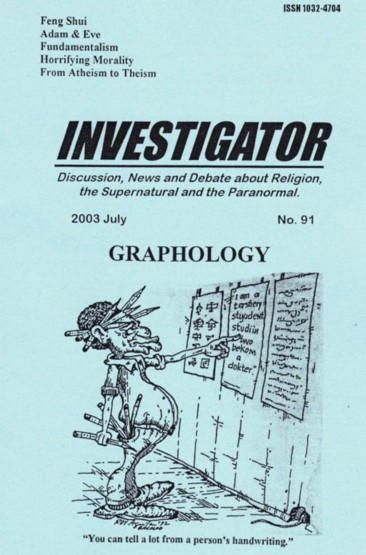 (Investigator 91, 2003 July)
The study of handwriting and its relation to personality goes back many centuries, but it was Camillo Baldi in 1622, who began the analysis of handwriting into its elements, giving impetus to the Abbe Hippolyte Michon and Crepieux-Jamin whose purpose was to relate specific elements in the handwriting to particular personality traits. Graphology is both an art and the science of handwriting analysis, and a distinction must be drawn between the two. As an art, graphologists maintain that by studying a person’s handwriting - the formation and size of the letters, the strokes, the dots, the slopes, the loops and tails – much can be learned about a person’s character, mental attitude, physical health and spiritual outlook. Graphotherapists maintain that they can eliminate a person's "bad" traits by improving their handwriting. In addition to character analysis, a study of the changes in a person’s handwriting can also be used to determine changes in mental and physical health and age. The difference in a person's handwriting say at the age of ten years and when they are seventy, is fairly obvious. This change from childish innocence and simplicity to the adaptation of an altered style dictated by the general physical changes associated with advanced age, is sometimes compounded by the development of senility, the characteristics of which are quite distinctive. Graphologists claim that monitoring one's handwriting from week to week can be a useful health indicator. A steady, even pressure with consistent letter forms and smooth uniform strokes are a general indication of good health. Conversely, light pressured strokes could mean low energy caused by being overtired or by having something on your mind. Likewise, the lack of coordination between muscles and nerves caused by stress would show up in your writing in the raggedness and unequal pressures of the strokes. They also maintain that one can also change one's life by changing a writing style, for example, if you are lacking in self-esteem raise the crossbar on your "ts", if you feel as though you are being taken advantage of, practise closing the loops on your written "ts", "ds" and "ss". Love, emotions and attitudes towards sex also manifest themselves in one’s handwriting, revealing personal hang-ups and tendencies towards exhibitionism. One study of graphology claims that gifted children can also be identified by their handwriting. Many employers today, particularly in the USA and Israel, are asking prospective employees for a handwriting sample for analysis by a graphologist, to determine their suitability for a position. Many of the conclusions are based on sound scientific reasoning revolving around brain and nerve functions. Although it appears to be a simple automatic action, the act of writing is in reality a direction of the brain which activates and coordinates muscles, nerves, organs and ideas into letters, words and sentences. Because the act of writing is not automatic and because script is not a simple gesture, the result of the overall complex functioning reflects the physiological and psychological aspects of and changes in a person’s character. However, the distinction needs to be made between the pseudoscience of graphology and handwriting analysis, otherwise known as historical or forensic document examination. Handwriting is so individual that like fingerprints, it is highly unlikely that two people, even though taught the same copy by the same teacher, would produce identical hands. This degree of individualization has assumed a great importance in courts of law in establishing the authenticity of a signature, and can be considered to be the science of graphology. Although writing experts presuppose that handwriting has certain characteristic features, they do not rely entirely on comparison with known examples; chemical and physical examination of the paper and ink, manufacturing dates, creases and other factors are taken into consideration before deciding on a sample’s authenticity. Personality evaluations however, are outside the ambit of identification and come under the heading of ‘entertainment’ graphology. Many investigations into the validity of handwriting as a character assessment tool have been carried out and few if any have shown there to be any significant positive correlation. Those that did, appear to have been based on the information revealed in handwriting samples with an autobiographical content. This suggestion was borne out in November 1989 when I contacted the only handwriting analyst advertising in the Sydney telephone directory under that category, and asked what she required in the way of a handwriting sample to give me a character assessment and a vocational guide. I was asked to supply my date of birth (which appears to be quite irrelevant), and a full resume of my life – education, employment, health, likes and dislikes, aspirations, etc: and a fee of $50. Others I have contacted also required a recent photograph, this in itself being significant! When I asked why all this information was required when it was supposedly to be obtained from a handwriting sample, she replied that she was not psychic or clairvoyant. With so much data on a person’s life made available prior to an assessment, the handwriting requirement seems superfluous and is no different (albeit more blatant) from the "cold reading" technique used by clairvoyants to obtain information from a client to be fed back at a later stage. Because
graphoanalysis
is alleged to reveal
capabilities and aptitudes in an individual of which even the applicant
may not be aware, thousands of businesses throughout Europe and the USA
are said to use graphology in employee selection. However, tests
carried
out to ascertain whether or not job success can be determined or
predicted
show that they are uniformly negative. One very disconcerting aspect of
graphology employed in this manner is that a job applicant may never
know
the reasons for his rejection, none of which may be true. Bibliography. Branston, B.
1989. Graphology
Explained. Judy Piatkus Ltd. UK. From: A Skeptic’s Guide to the New Age, 1995, Harry Edwards. https://ed5015.tripod.com/ https://investigatormagazine.net |